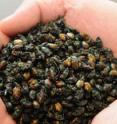Where are you now, my love?
Related images
(click to enlarge)
Having a good nose is essential to a Japanese beetle's survival. The beetle's sense of smell helps it avoid enemies and zero in on a mate. Meanwhile, the potential mate is programmed to release sex pheromones in exactly the right proportions. Like cheap perfume, there is such a thing as too much: Excessive pheromones can get the attention of a passing fly, leading her to the beetle. The fly can then lay her eggs on the beetle's back, setting up emerging fly larvae for their first meal (fresh Japanese beetle). If all of this isn't challenging enough, the male beetles have to track females while they're both flying. This requires a mechanism within the males that loses the pheromone scent from a moment before and picks up the latest scent as the females move through the air.
This mechanism is well understood by Walter Leal, a chemical ecologist at the University of California, Davis. With funding from the National Science Foundation, Leal has isolated, identified, cloned and expressed a pheromone-degrading enzyme that allows receptors in the beetle's nose to lose the pheromone scent from the female's earlier locations as she moves to new places.
Isolating this enzyme offers the potential to eliminate entirely the beetle's reception of the pheromone scent, making them unable to find females, mate and reproduce. This potential could be useful to agricultural pest control, since the Japanese beetle is an invasive species responsible for millions in damages to crops each year.
Source: National Science Foundation
Other sources
- New research could lead to no scent, no sex for the Japanese beetlefrom PhysorgMon, 30 Jun 2008, 15:07:50 UTC
- No Scent, No Sex For The Japanese Beetlefrom Science DailyThu, 26 Jun 2008, 14:28:14 UTC

